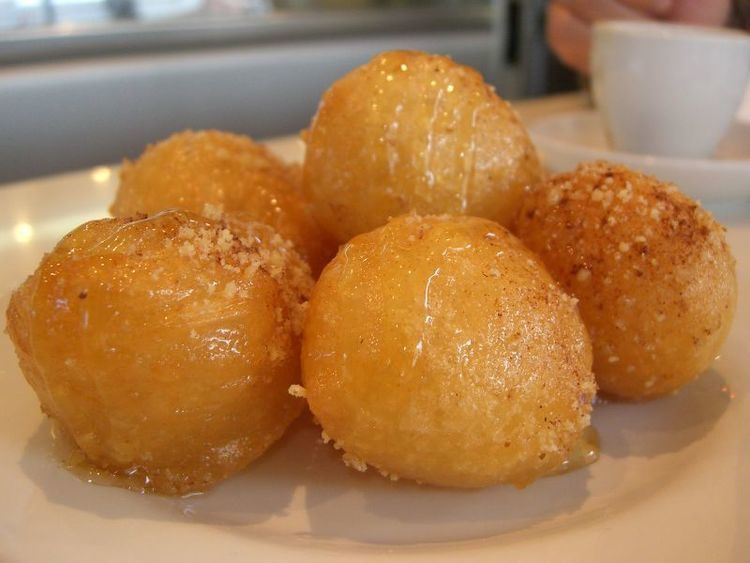Type Fried dough | Main ingredients Dough | |
 | ||
Alternative names Zalabyieh, Loukoumades, Lokma, Lokmades, Luqmat, Bamiyeh Place of origin Syria, Greece, Cyprus, Turkey, Egypt, Levant Variations Sugar syrup, honey, cinnamon, chocolate syrup | ||
loukoumades (Greek), loukmades (Cypriot) Lokma (Turkish), Greek: λουκουμάδες, singular λουκουμάς, loukoumas), zalabyieh (Arabic: زلابية), or bāmiyeh (Persian: بامیه), — see etymology below — are pastries made of deep fried dough soaked in syrup, chocolate sauce or honey, with cinnamon and sometimes sprinkled with sesame or grated walnuts.
Contents
Etymology
The Turkish word lokma means 'mouthful' or 'morsel', from Arabic لقمة luqma(t). A version called لقمة القاضي luqmat al-qādi (judge's mouthful) was described by al-Baghdadi in the 13th century and continues to be made in Arab countries.
Regional varieties
Greece and Cyprus
In Greece and Cyprus, loukoumades are commonly spiced with cinnamon in a honey syrup and can be sprinkled lightly with powdered sugar. Loukoumades are a traditional Greek dessert with roots in deep antiquity, although some disagreement exists over which historical Greek honey-cake is the ancestor of the modern loukoumas, whose present name is borrowed from Arabic via Turkish. The candidate most frequently mentioned as being prepared with hot oil is enkris, which is described below along with other postulated ancestral honey-cakes.
Callimachus. "Callimachus, Fragments of Uncertain Location". doi:10.4159/DLCL.callimachus-fragments_uncertain_location.1973. Retrieved 25 June 2015. – via digital Loeb Classical Library (subscription required)
This fragment from Callimachus has been used to argue the supposed antiquity of loukoumades and a connexion to the ancient Olympics by, among others, The Washington Post. Various assertions have also been made regarding ompne (Ancient Greek: ὄμπνη) in the text means, in the plural form, "sacrificial cakes made of grain and honey". Other sacrificial cakes, often called popanon (Ancient Greek: πόπανον) being ancestral to loukoumades; however, the only thing that is clear about them is that they were made from grain and honey.
Ancient enkrides
A dish very similar to loukoumades is described by Archestratus, a Greek poet from Sicily, was enkris (Greek: ἐγκρίς, plural ἐγκρίδες) — a dough-ball fried in olive oil, which he details in his Gastronomy; a work now lost, but partially preserved in the Deipnosophists of Athenaeus, which mentions enkris thirteen times, in various inflected forms. The most complete description of it in the Deipnosophists is a passage that reads:
πεμμάτιον ἑψόμενον ἐν ἐλαίῳ καὶ μετὰ τοῦτο μελιτούμενον, μνημονεύει αὐτῶν Στησίχορος διὰ τούτων
χόνδρον τε καὶ ἐγκρίδας ἄλλα τε πέμματα καὶ μέλι χλωρόν.
There are cakes, also, called ἐγκρίδες. These are cakes boiled in oil, and after that seasoned with honey; and they are mentioned by Stesichorus in the following lines:—
Groats and encrides, And other cakes, and fresh sweet honey.
It is also mentioned in preserved fragments of Aristophanes's Danaids and Pherecrates's Crapataloi, Stesichorus, and Antiphon
This word is also used in the Greek Septuagint to describe the manna eaten by the Israelites in the Book of Exodus
καὶ ἐπωνόμασαν οἱ υἱοὶ Ισραηλ τὸ ὄνομα αὐτοῦ Μαν ἦν δὲ ὡς σπέρμα κορίου λευκόν τὸ δὲ γεῦμα αὐτοῦ ὡς ἐγκρὶς ἐν μέλιτι
And the house of Israel called the name thereof Manna: and it was like coriander seed, white; and the taste of it was like wafers made with honey.
And also in the Book of Numbers,
«καὶ διεπορεύετο ὁ λαὸς καὶ συνέλεγον καὶ ἤληθον αὐτὸ ἐν τῷ μύλῳ καὶ ἔτριβον ἐν τῇ θυΐᾳ καὶ ἥψουν αὐτὸ ἐν τῇ χύτρᾳ καὶ ἐποίουν αὐτὸ ἐγκρυφίας, καὶ ἦν ἡ ἡδονὴ αὐτοῦ ὡσεὶ γεῦμα ἐγκρὶς ἐξ ἐλαίου»
And the people went about, and gathered it, and ground it in mills, or beat it in a mortar, and baked it in pans, and made cakes of it: and the taste of it was as the taste of fresh oil.
Also, there may be a connection to the ritual feeding of the victors at ancient Olympia. Aristotle and other ancient writers refer to kharisioi plakoi or plakonta (χαρίσιοι πλάκοι, πλακούντα), translated as "(thanksgiving) cakes or "(gift) cakes". These were offered to the victorious athletes in a highly ritualized ceremony along with the kotinos wreath. No recipe survives.
Turkey
Lokma is a dessert made of flour, sugar, yeast and salt bathed with syrup or honey. Lokma was cooked by the sultan's cooks at Ottoman Empire palaces, and for centuries. Lokma in the turkish cuisine is appeared in Kara-Khanid Khanate [7], in the 9th century (Tercüme-i Kenzü-l İştihâ by Ahmed Cavid, 15th century). Lokma is a tradition for Turks. In someone's death anniversary, close relatives or friends of him/her cook and serve lokmas to neighbours and passengers.
Sfingi
The pastry is called sfingi (σφίνγοι) by the Greek Jews, who make them as Hanukkah treats. It is claimed to have been originated by the Romaniotes. A similar dish is also found in Italy as Sfingi di San Giuseppe.
Other regions
Various other kinds of fried dough with syrup are found in the Mediterranean, the Middle East, and South Asia, from the Italian struffoli (the most similar in preparation to loukoumades) and zeppole to the Indian and Pakistani jalebi and gulab jamun.
Perhaps the oldest documentation of a related but not identical dish is in the tomb of Ramses IV, where something more like jalebi is shown being prepared. Later, the Ancient Greek enchytoi consisted of a cheese-and-flour dough squeezed into hot fat, then covered with honey.
